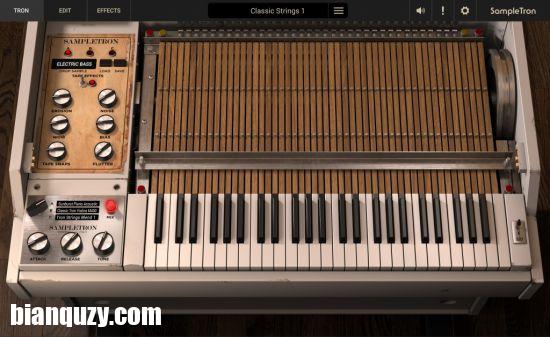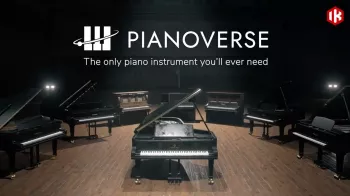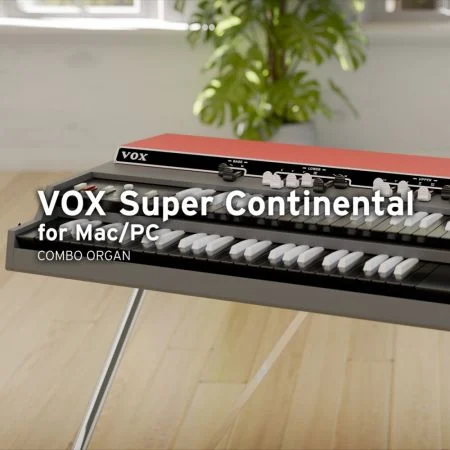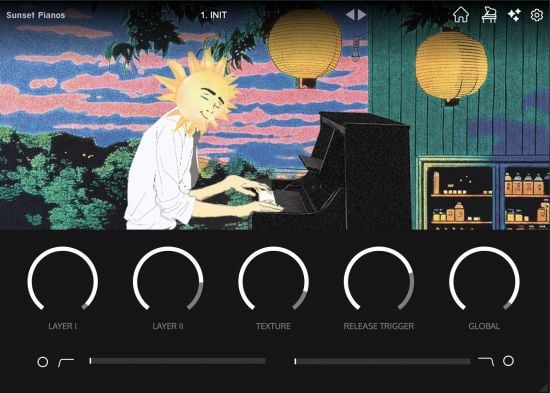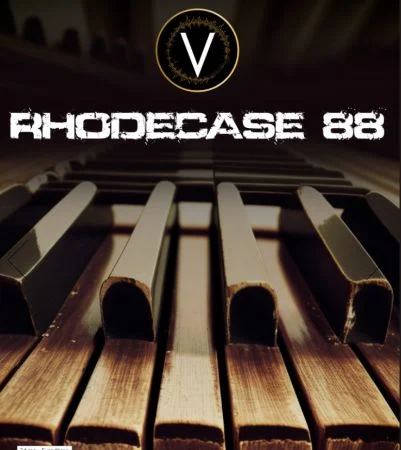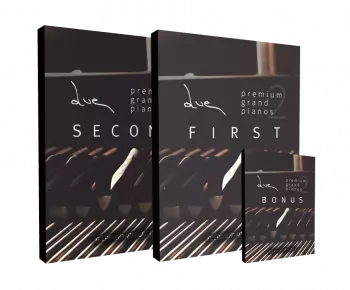
KONTAKT – 16,38 GB | Incl. BONUS Patches
C3 + c7
当Flavio和团队决定制作这个样本库时,他们想要创造一些特别的东西,一些独特的东西,可以真正保持原声钢琴的真正本质。我们结合了采样艺术和脚本艺术来制作最好的采样钢琴,以满足最苛刻的作曲家和音乐家。
实验Due是我们的新哲学钢琴库,包含两个高级钢琴记录与高端齿轮和独特的细节。
– 2美丽的采样钢琴在一个图书馆:一个C7大尾声和一个C3半尾声
– 14个动态图层彩色采样
– 16,6gb, 9500个样本和1年的工作
-最多3个麦克风位置:Close, Player(仅C7), Room
-真正的交感共振,泛音和先进的重复模拟
-塑造你的声音与“共振”,“音调平衡”和一个集成信封。
– 15个噪音层(棉花,树叶等)和9个乐器层(合唱团,坎特雷等)
-新!“感觉”模拟了一个加权键盘的反应
-新!现在Due支持半踏板
每个钢琴家都知道不是所有的钢琴都是一样的。每种乐器都有不同的触感和颜色,有时为合适的作品找到合适的钢琴是很重要的。
这就是为什么我们采样两种仪器如此深入:我们想给我们的客户自由选择两种不同的仪器,记录两者具有相同的质量。
记录的艺术
经过无数次的测试,我们在赫尔辛基西贝柳斯学院工作室的两个漂亮的房间里,只使用DPA, Neumann, Gefell等高端麦克风录制钢琴。
脚本的艺术
我们模拟了钢琴的声学行为,结合了精细的机制采样(如锤子和踏板的噪音)和脚本的物理建模哲学。
游戏的共鸣
我们相信钢琴不仅仅是声音的总和:事实上,在一个复杂的游戏中,所有的琴弦在演奏时都是相互“互动”的。我们通过两种方式重现了这种互动:
泛音:我们对“泛音”进行了采样,这是由一个特殊的引擎控制的琴弦通过交感共振产生的谐波共振。我们也采样了声音的弦与维持踏板下来。
脉冲响应:我们与西贝柳斯学院音乐技术部合作,对C7琴弦和琴身的脉冲响应进行采样。
共振峰控制
“音峰”允许你通过改变音的音峰来使钢琴的声音“更大”或“更小”。它既可以用来塑造声音,也可以用于创作目的。在最大值/最小值上,您可以创建慢速效果(如在演示中)或花栗鼠曲调。
麦克风的设置
我们用多个麦克风位置对钢琴进行采样。
-“贴近”:麦克风贴近琴弦,声音现代干净。
-“播放器”:麦克风与播放器在同一位置。声音结果令人难以置信的自然和良好的平衡。
-“房间”:麦克风离钢琴很远,所以它们会捕捉到录音室的反射。声音很宽,很适合古典音乐。
层
扩展你的可能性:Due允许你在钢琴的声音中添加噪音或乐器层。有了这个功能,可以创建一个感觉像钢琴(与棉花层)或一个完整的声音预设(与唱诗班层)。
-噪音层:棉2、棉2、软棉、纸、海绵、树叶、Perc弦、键、金属、塑料1、塑料2、暖塑料、玻璃、铃铛1、铃铛2
-乐器层:钟,坎特尔琴,钢琴,谐波,合唱团,吉他,钟琴,电颤琴,吉他
Oldify
“Oldify”是一个效果集合,允许您模拟旧录音。
磁带增加了声音的谐波失真
-颤振模拟磁带的快速调制
-哇模拟磁带的缓慢和随机调制
-滤波器是一个带通滤波器:在这里你可以很容易地模拟蹩脚的扬声器,像一个电话
卷积混响
选择17卷积混响,并把你的钢琴在你想要的地方!
IR混响:1号房间,2号房间,1号大房间,2号大房间,3号大房间,1号大厅,2号大厅,木材1号,木材2号大厅,歌剧大厅,1号停车场,2号停车场,1号教堂,2号教堂,竞技场,春天。
需要完整版本的NI Kontakt v5.5.1或更高!
C3 + C7
When Flavio and the team decided to make this sample library, they had in mind to create something special, something unique, that could really keep the real essence of the acoustic piano. We combined the art of sampling and the art of scripting to make the best sampled piano we could, made for satisfying the most demanding composers and musicians.
XPERIMENTA Due is our new-philosophy piano library, containing two premium pianos recorded with top-end gear and unique detail.
– 2 beautiful sampled pianos in one library: a C7 Gran Coda and a C3 Half Coda
– 14 Dynamic Layers chromatically sampled
– 16,6GB, 9.500 samples and 1 year of work
– Up to 3 Microphone positions: Close, Player (only C7), Room
– Real Sympatetic Resonance, Overtones and advanced Repedaling simulation
– Shape your sound with “Formant”, “Tone balance” and an integrated envelope.
– 15 noise layers (cotton, leaves, etc.) and 9 instrument layers (choir, kantele, etc.)
– New! “Feeling” simulates the responce of a weighted keyboard
– New! now Due supports Half Pedaling
Every pianist knows that not all the pianos are the same. Each instrument can have a so different touch and color, and sometimes it is important to find the right piano for the right piece.
This is why we sampled two instruments so deeply: we wanted to give to our customers the freedom to choose between two different instruments, recorded both with the same quality.
The art of recording
After endless sessions of testing, we recorded the pianos using only top-end microphones as DPA, Neumann, Gefell, in two beautiful-sounding rooms in Sibelius Academy Studios, Helsinki.
The art of scripting
We simulated the acoustic behaviour of the piano, with a combination of fine sampling of the mechanics (i.e. hammer and pedal noises) and a phisic-modeling philosophy of scripting.
The game of the resonance
We believe that a piano is not just a sum of its sounds: indeed, all the strings “interact” each other when played, in a complex game. We recreated this interaction in two ways:
Overtones: We sampled the “overtones”, that are the harmonic resonances that the strings generate by sympathetic resonance, controlled by a special engine. We also sampled the sound of the strings with the sustain pedal down.
Impulse Response: in collaboration with the Sibelius Academy Music Technology Department, we sampled the impulse response of the strings and the body of the C7.
Formant control
“Formant” allows you to make the sound of the piano “bigger” or “smaller”, by changing the formant of the sound. It can be used both for shaping the sound and for creative purposes. On maximun/minimum values, you can create a slow-down effect (like in the demo) or a chipmonk tune.
Microphone settings
We sampled the pianos with multiple microphone positions.
– “Close”: the microphones are close to the strings, and the sound is modern and clean.
– “Player”: the microphones are in the same position of the player. The sound results incredibly natural and well balanced.
– “Room”: the microphones are far from the piano, so they will capture the reflection of the recording room. The sound is wide and it fits well with classical music.
Layers
Expand your possibilities: Due allows you to add a noise or an instrument layer to the sound of the piano. With this feature, is possible to create a felt-like piano (with a cotton layer) or a full sound preset (with a choir layer).
– NOISE LAYERS: Cotton 2, Cotton 2, Cotton Soft, Paper, Sponge, Leaves, String Perc, Key, Metal, Plastic 1, Plastic 2, Warm Plastic, Glass, Bells 1, Bells 2
– INSTRUMENT LAYERS: Bells, Kantele, Piano, Harmonics, Choir, Guitar, Glockenspiel, Vibraphone, E. Guitar
Oldify
“Oldify” is a collection of effects that allows you to simulate an old recording.
– Tape adds an harmonic distorsion to the sound
– Flutter simulates a fast modulation of the tape
– Wow simulates a slow and random modulation of the tape
– Filter is a band-pass filter: here you can easily simulate crappy speakers, like a phone-call
Convolution Reverb
Choose between 17 convolution reverb, and place your piano where you want!
IR Reverb: Room 1, Room 2, Large Room 1, Large Room 2, Large Room 3, Hall 1, Hall 2, Wood 1, Wood 2, Large Hall, Opera Hall, Parking 1, Parking 2, Church 1, Church 2, Arena, Spring.
Requires the FULL version of NI Kontakt v5.5.1 or higher!
